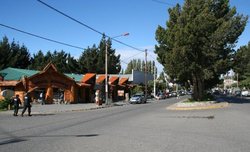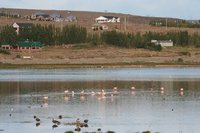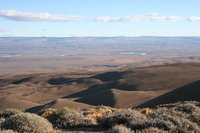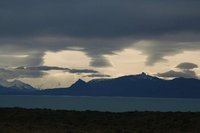
El Calafate El Calafate is a very picturesque town with
a population of 7000, located at the foot
of Mount Calafate and on the bank of Lago
Argentino. It is the entry town to the national
park and is very and organised. The shops
are geared towards the tourists and there
are many tourist agents. Hordes of people
from around the world come to El Calafate
every year to see the glaciers and the Andes.
So the business must be good there.
It was relatively expensive but a pleasant
and fully civilised place where the sun did
not set before 22.00 and the shops didn’t
shut much before that.
The typical buildings are very bright colours
with sloping roofs and the vegetation is
bright green with many different flowers,
including large roses.
The climate is mainly dry with an average
temperature of 18.6º C (65ºF),
but the prevailing westerly and south-westerly
winds make it VERY cold – jacket, woollen
hat, gloves and scarves are necessary wear.
El Calafate is named after a small bush,
calafate (Magellan Barberry), which grows
in the southern part of Patagonia. The locals
state that anyone eating from the fruit will
return for more! Patagonian dishes combine the coexistence
of aborigine and European immigrants - barbecued
meats (especially lamb), local fish and seafood,
smoked meats, autochthonous fruit jam and
patisseries. Apparently, a wide range of
white and red wines are produced in Patagonia,
although we only saw a few.
 |
| Flamingos on the lake |
|
 |
| The open plains |
|
 |
| Interesting cloud formations |
|
Walichu Caves
Situated just 8km from El Calafate, this
is one of Argentina's most historically
significant treasures. Located just off of
the shore of Lake Argentina, or Lago Argentino,
these caverns are filled with archeologically
significant Paleolithic cave paintings. They
were discovered in 1877 by Francisco Pascasio
Moreno, a notable explorer in the region.
A visit to the Walichu Caves will transport
you back over 4,000 years ago, to a time
when Argentinean aborigines used drawings
of maps, people, and animals to aid fellow
hunters and gatherers in the region. Created
with materials such as gypsum, egg-whites,
plant resin, and human saliva, many of the
painting have survived the ages due to the
protective environment of the caves. Those
that have deteriorated due to thousands of
years of weathering have been partially restored.
Signs of the Paleolithic Era
The Paleolithic Era, which began with the
use of the first stone tools and ended with
the introduction of agriculture, was marked
by the necessity of hunting and scavenging
activity for survival. Because of this need,
many early human beings used cryptic paintings
and sketches to illustrate maps of the land
and successful hunting areas for their fellow
tribe-mates to utilize. The Walichu Caves
house many illustrations of the surrounding
landscape and wildlife. The early humans
of the area have passed on their knowledge
of the plants, herbs, and animal populations
in the cave drawings.
The Tehuelche People
Tehuelche is the name given to the numerous
native tribes of the Argentinean Patagonia.
It was one of these tribes that created the
cave paintings that adorn the walls of the
Walichu Caves still today. In fact, the name
Walichu comes from the name of a Tehuelchian
deity that was a central figure in the culture's
spiritual practice. These early Patagonian
dwellers are now believed to be synonymous
with the Patagones, a race of so-called "giants"
described by European explorers travelling
within southern South America.
History
Long before the glacier age, some 9000 years
ago, the forefathers of the “tehuelches”
settlers arrived to this area from the north.
When the white man discovered the coasts
of Santa Cruz, there were many Patagonian
aboriginal people. The 1889 census estimated
24,000, but in 1895 they had decreased to
only 5,500.
They had an outstanding physical strength
due to the permanent effort to survive in
a hostile environment, typical of the aborigines
of Santa Cruz. They showed solidarity, no
ambitions and always ready to help those
in need, including the first Spanish settlers.
Their supreme god was Elal, whom they believed
had created the animals and the indigenous
people. In their social organization, the
Chief had the maximum authority and he was
the only person who had more than one wife.
Fathers showed great affection for their
children and taught them how to ride horses,
throw arrows and “boleadoras”
(a hunting weapon made of big round stones
tied at the end of a rope). They ate what
they hunted, guanacos and choiques (ostriches),
they gathered wild fruits, herbs, berries
and seeds of which they made flour for their
sustenance. They wore loincloths and covered
their bodies with furs to go hunting, and
they painted their faces with different colours
to indicate whether they were at war or peace.
Their dwellings were tents made with logs,
stones and guanaco skins which they laid
on the floor to sleep on. No original inhabitants
remain; they are completely extinct, except
for a few descendants of mixed race.